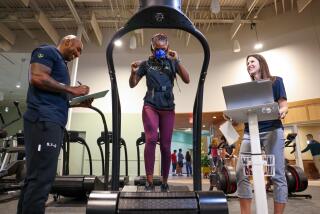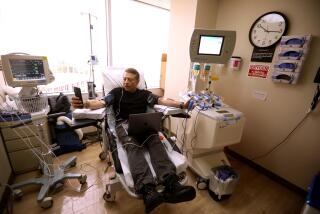The Cutting Edge: COMPUTING / TECHNOLOGY / INNOVATION : A WELLness Community That’s Part Net, Part Encounter Group
- Share via
When Tom Mandel caught a nasty cold last year, he did what comes naturally when you’re one of the most prolific citizens of the on-line community known as the WELL. He posted to the service’s Health conference.
When the cold wouldn’t go away, he reported on how it lingered. And when he went to the doctor, he reported on the chest X-rays, the tuberculosis test, and eventually, on the diagnosis of inoperable lung cancer.
Mandel’s riveting account of his struggle with disease prompted an outpouring of emotion, prayer and “beams”--WELL-wishes, you could call them--from users who had often argued with him in the past. WELL subscribers offered poetry, advice and information, cheered when there was good news and commiserated when there was bad. When Mandel posted a farewell message to his friends and former enemies, the WELL response was heartfelt, and when it was reported that he and another WELL user were to marry, the system erupted in congratulations.
That’s the WELL for you. Lots of on-line services claim to be virtual communities, but hardly any even come close to the quirky, Sausalito-based system that sometimes seems part Internet and part encounter group.
The WELL turned 10 years old Saturday, having reached this advanced age as the larger world of cyberspace has undergone a sweeping democratization marked by millions of new users. Protected by high prices, a cryptic interface and the need for far-off users to dial long-distance, The WELL hasn’t been swamped by this demotic tide. With about 11,000 subscribers, it remains a virtual hamlet compared to the sprawling metropolises of Prodigy, CompuServe and America Online.
I confess I’ve never been much interested in the WELL, which had always seemed to me kind of like Marin County, where it lives--a really nice place where everything costs a fortune and nobody eats meat. I resented what I imagined was the Celestial Seasonings liberalism of the place, and I hated the hieroglyphics you had to master in order to use the service. One on-line veteran I know, complaining of the WELL’s intense self-importance, offers an analogy: “Imagine Spago with bad food.”
*
But the WELL is worth another look, not just for what it is--a place with very good food, in a manner of speaking--but for the way it illustrates the potential and the pitfalls of a tight-knit on-line community. The system’s new owner says that in the next few months he hopes to unveil a new graphically oriented interface, local dial-up numbers in 80 U.S. cities and considerably lower prices. There are also plans--or at least hopes--to create more WELL-like on-line communities elsewhere.
In all likelihood, the result will be droves of new users, a prospect that has a good many “WELLbeings,” as the service likes to call its subscribers, up in arms.
As things stand, the WELL is not a great place to talk about pro football, new cars or cats. Rush Limbaugh doesn’t live here. On the other hand, there are conferences with titles such as Holistic, Tibet, Gnosis, Co-Housing, Recovery, Sustainability, Libertarianism, Eros and, of course, Berkeley. It’s the kind of stuff you’d expect to find on a system co-founded by Stewart Brand, of Whole Earth Catalog fame. The WELL’s name is an acronym, after all, for Whole Earth ‘Lectronic Link.
*
Yet the WELL is hardly just a convenient place for trading sprout recipes, having played an important role in the history of cyberspace. For example, the Electronic Frontier Foundation grew out of discussions on the WELL, and WELL staffers assisted in the capture of elusive alleged computer cracker Kevin Mitnick.
Still, it is the conferences that make the WELL. There’s a coziness about these forums that comes of talk between people who really seem to know each other. And the talk itself is often delightful--moving, even, as it has been in the case of Tom Mandel.
Jim Warren, a former Silicon Valley entrepreneur who devotes himself now to open-government activism, has been using the WELL for several years and explains why he likes it: “The quality of participation in the conferences on the WELL is just orders of magnitude higher in quality than the unmoderated discussions on any other system I’ve seen.”
*
So let’s face it, a big part of the WELL’s charm is that it is small, and that its users are something of an elite. But the WELL is a business, after all, one owned nowadays by Bruce R. Katz, who made a fortune as the founder of Rockport Shoe Co., which was sold to Reebok International in 1986. We’re not talking Charles Keating here; Katz (who pronounces his name Cates) acquired half the WELL four years ago, and is active in various do-good and pro-environment causes. He is exquisitely conscious of the conflict between opening up the WELL and letting hoi polloi trample the place.
Although Katz says the WELL is profitable, it is also clearly being overtaken by competitors offering more for less. Katz’s challenge is finding a way to maintain the character of the WELL while making it easier to use--and bringing users the latest that cyberspace has to offer.
He insists his goal is to avoid blasting apart the intimate little community that the WELL is today. Instead, he says, the idea is to replicate it in other cities where similarly close-knit on-line worlds might be constructed, whether under the WELL name or called something else.
“By building and/or helping to build other community systems,” Katz told me by electronic mail, “we can take what we have learned in the original WELL and develop new community systems.”
I fervently hope he succeeds. Meanwhile, Tom Mandel struggles on against cancer, and on the WELL, the beams keep pouring in.
*
Daniel Akst is a Los Angeles writer. He welcomes messages at akstd@news.latimes.com but regrets that he cannot reply to every one.
(BEGIN TEXT OF INFOBOX / INFOGRAPHIC)
WELL Connection
If you want to try the WELL, you can dial it with your modem at 9600 bps and above at (415) 332-8410. If you use a slower modem, dial it at (415) 332-6106. Internet users may find it cheaper to telnet to well.com, and the WELL can suggest other connection options that can save money on your phone bill.
However you get there, you can register as a new user on-line. But the service isn’t cheap; using the WELL will cost you $15 a month plus $2 an hour (you get five free hours at the outset, and you’ll need at least that many to learn the system).






